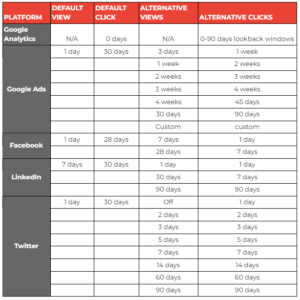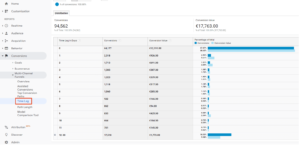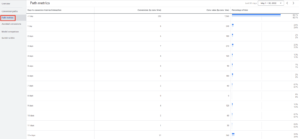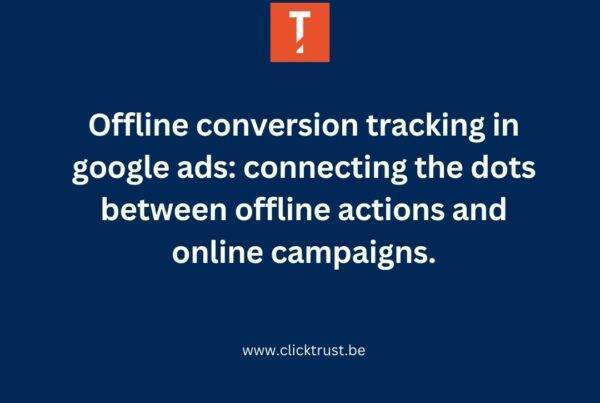More than ever, we keep repeating how essential understanding the customer journey is in order to make strategic decisions. But have you ever wondered how to use it for the configuration of your conversions in your ad accounts? And what impact can this have on your results?
This is what we will explain to you throughout this blog post.
The importance of the customer journey
Due to the appearance of new advertising channels and that the social media market has diversified significantly, the buying journey has become more complex and longer than ever. This is why the mapping of the customer journey is essential, as it will allow you to maximize your performance and have a better understanding of the interactions of your users with your brand. You will have to analyze this purchase journey from start to end to identify the different touchpoints.
How can this impact your results?
Having a good understanding of the customer journey will allow you to make decisions for the configuration settings for your conversion actions, such as the attribution model, the conversion counting method, and the lookback window. These settings are often overlooked but can be hugely important. In a smart bidding world, there’s only so much that you can control, and feeding the algorithm with the best possible conversion data should be a no-brainer.
Whether you have a long customer journey, repeat purchases, or a short customer journey will have an impact on the choices you make in your configuration.
Example: If you notice that you have a long customer journey (buying a car, buying a house,…), this will influence your choice regarding your conversion window. You will choose a configuration of 90 days conversion window in order to collect as much information as possible on all the touchpoints and to give more signals to the algorithm to optimize your campaigns.
The impact of the configuration on the conversion windows
As highlighted above, the customer journey has become increasingly long and complicated, and this can be partly explained by the multitude of platforms that now exist. Since each platform has its own default view, as explained in our article discrepancies in conversion tracking between different platforms, this makes data analysis even more complex. This is why it is important to choose these settings carefully.

Knowing that this choice will have a direct impact on your data, your cost per conversion, and your decision-making, the question is how to determine the lookback window (how far back in time you want to involve the touchpoints of the user journey) and what type of lookback window (clicks or impressions) to use?
The answer is to think logically. Think about how long it takes for a person to make a purchase to define this window. You can also use the tools available in Google Analytics (Time Lag report) and in Google Ads (Path Metrics report), but keep in mind that these reports are still mostly cookie-based, so they are far from perfect. Any qualitative research you have on this should be considered more accurate than what the reports in analytics or Google Ads say.
Time Lag report
Path Metrics report
Examples
1) For businesses where you buy a lot of items, for example, Becharge. As the reflection time is shorter and the quantity of products you buy is bigger, your conversion window can be shorter. A lookback of 30 days or even smaller will be sufficient.
2) For the purchase of a high-quality sofa of a certain price, the time of reflection will undoubtedly be longer than for the purchase of a pair of pants, for example. It’s possible that an awareness ad or a search ad helped lead the person to a store within days. In this case, a 30-day lookback could be relevant, since the user’s journey will be longer and different touchpoints will have been useful.
3) The purchase of a car requires much more time to make a decision. Different touchpoints will have been necessary to help choose the model, the dealer, and the visit to the garage. In order not to minimize the impact of the various touchpoints and especially of the first ones that will have had a role in this user’s journey, a lookback of 60-90 days would be relevant.
This logic applies from a global point of view, but also between the different channels and campaigns. For example, we will have different lookbacks between display (longer lookback) and SEA Brand (shorter lookback) in order to give credit to the channels that are at the top of the funnel and to maximize the acquisition side.
We also need to distinguish between soft and hard conversions. A soft conversion, such as a qualitative visit, could use a smaller conversion window than a hard conversion, such as a transaction, as it’s something that takes less time.
The conversion window is obviously not the only element that impacts the credit given to the different touchpoints. The attribution model that we configure in our conversions will have an essential impact.
The choice of attribution model
With the right attribution model, we can better understand which part of the funnel has a direct impact on the final lead. Each attribution model has certain specificities, some give more credit at the beginning of the journey while others will maximize the end of the journey or still others will try to evenly distribute the credit throughout the user’s journey. By using the wrong attribution model, you risk failing to interpret results and wasting money on channels that don’t deliver results.
How to choose the model that suits your business and your customer journey?
There are many attribution models, but we will briefly walk through the 6 most used models within Google below:
1) Last click attribution model: Default attribution model in Google Ads and the most used model. This one gives 100% credit to the last touchpoint. The problem is that this model will tend to give all the credit to the brand terms when there will undoubtedly have been other keywords that will have led to the final conversion, which is problematic from an incrementality point of view.
2) First click attribution model: Unlike the previous model, this one will give credit to the first point of contact of the customer journey. This can sometimes be slightly problematic because the conversion will often be attributed from the top funnel when we don’t know not how many touchpoints it will take for a person to convert.
3) U-Shape / Position-based attribution model: Compromise between the previous two models. The inconvenience with this attribution model is that it arbitrarily gives too much credit to the first and last touchpoints without giving enough credit to what happens in the middle, which will also help with the conversion.
4) Linear attribution model: Similar to the previous model except that in this case, this model will give credit to all touchpoints equally. The problem is that each touchpoint does not necessarily deserve to receive the same credit. This will prevent you from focusing on what really matters.
5) Time Decay attribution model: Seen as an improvement on the last-click attribution model, in this model the last touchpoint receives the majority of the credit but all other points leading to that conversion also receive credit. The disadvantage? Even if all points are taken into account, the last point of contact will probably receive too much credit, which again gives too much credit to brand terms.
6) Data-Driven attribution model: Relatively recent model (2016) based on data. Google analyzes all the conversion data and decides how to distribute the credit between the different touchpoints. However, this model is intended for large accounts that generate sufficient volume in terms of clicks and conversions. It’s also important to be aware that DDA is not the magic solution to attribution that Google says it is. DDA still makes decisions on cookie-based conversion data (which is inherently flawed, especially for longer customer journeys) and it doesn’t have the required data to know which conversions are incremental. So, expect branded paid search and retargeting campaigns to still be overvalued.
The choice between these different attribution models will depend on your business model and your objectives. The best way to choose is to think carefully about every aspect of your brand. Is this a new brand? Do you want to do acquisition or retention? What is your target? How many channels do you use?
Depending on what you have identified, different attribution models can be used.
Example: Repeat purchases
You have a business model where repeat purchases are very present. In that case, you will have a different approach between acquisition and retention. Indeed, it could be a good idea to separate your campaigns to maximize acquisition by using different conversions with different conversion settings:

In acquisition, you do not want to count several conversions because someone can only become a customer once. In retention, on the other side, you’re going to want to count every conversion since a repeat purchase can be made multiple times. This will give a more relevant view of performance.
For the conversion window, as explained above, think about what makes sense according to the customer journey. You can use the reports available in Google Analytics (Time Lag report) and Google Ads (Path Metrics report). As a rule of thumb, use an attribution model that rewards more towards the last click for retention and towards the first click for acquisition.
Discover our 10 tips for managing campaigns for businesses with recurring purchasers.
Example: Long and complicated customer journey
You have a long and complicated customer journey. For example, you have a company in the construction of houses, where people will take several weeks or even months to make the final purchase. If you are currently using the last-click attribution model and a 30-day conversion window, you will tend to overinvest in the bottom of the funnel and in brand terms. This will impact your results since you will not have not a holistic approach in which you are taking into account the different touchpoints of the customer journey that impact the acquisition and subsequently your ROI in the long term.
For this kind of business model, we typically recommend increasing the conversion window to 60 or 90 days. This will allow you to analyze customer behavior over a longer period, which is crucial when the purchase is not impulsive.
In order to focus on acquisition and to have a better understanding of the customer journey, we recommend switching to a first-click or position-based attribution model, for example. This will allow you to have a more global view of what prompted the customer to make the final purchase. At the same time, it will allow you to give more credit to generic keywords or to channels that are at the top of the funnel, such as display. In the end, this change in approach and configuration in your conversions will allow you to review your budget split to invest where it will have an impact. Find out how it can help you increase your lead volume.
Example: Frequent and impulsive purchases
If you have a business model where the purchase is very frequent and impulsive, such as Amazon, and you, therefore, have a short customer journey, the last click model will absolutely not be a problem. This will give credit to whatever is at the bottom-of-funnel channels or search ads, which will simply have the customer converting almost immediately. If the behavior of the customer is impulsive and the notoriety of the brand is already well implemented, awareness will play a less important role. We can therefore apply the same logic to the conversion window. Since the reflection time will be less, a 30 days conversion window will be sufficient.
We encourage you to do the same exercise with your own business model. Start by identifying which kind of customer journey you have and what your end goal is. Then apply the same logic as above to identify which configuration settings you should use on your conversions.
Ontvang onze inzichten rechtstreeks in je inbox
We duiken regelmatig in actuele onderwerpen op het gebied van digitale marketing en delen onze inzichten graag met jou.



